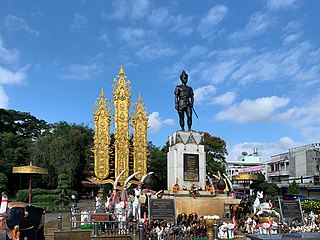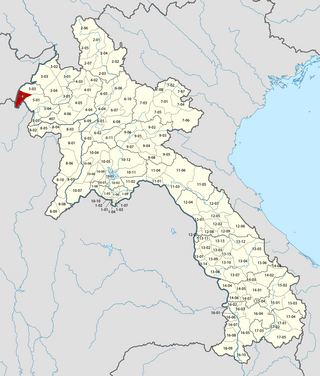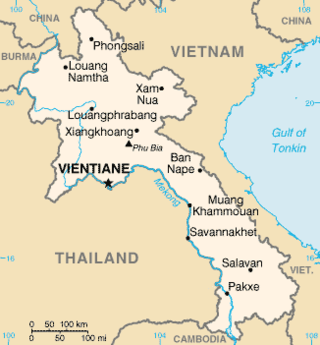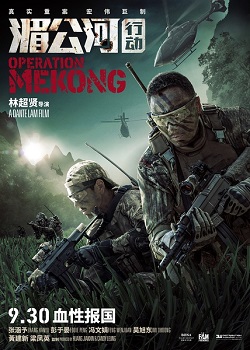
The Mekong or Mekong River is a transboundary river in East Asia and Southeast Asia. It is the world's twelfth-longest river and the third-longest in Asia with an estimated length of 4,909 km (3,050 mi) and a drainage area of 795,000 km2 (307,000 sq mi), discharging 475 km3 (114 cu mi) of water annually. From its headwaters in the Tibetan Plateau, the river runs through Southwest China, Myanmar, Laos, Thailand, Cambodia, and southern Vietnam. The extreme seasonal variations in flow and the presence of rapids and waterfalls in the Mekong make navigation difficult. Even so, the river is a major trade route between Tibet and Southeast Asia. The construction of hydroelectric dams along the Mekong in the 2000s through the 2020s has caused serious problems for the river's ecosystem, including the exacerbation of drought.

The Shan people, also known as the Tai Long or Thai Yai, are a Tai ethnic group of Southeast Asia. The Shan are the biggest minority of Burma (Myanmar) and primarily live in the Shan State of this country, but also inhabit parts of Mandalay Region, Kachin State, Kayah State, Sagaing Region and Kayin State, and in adjacent regions of China, Laos, Assam and Meghalaya, Cambodia, Vietnam and Thailand. Though no reliable census has been taken in Burma since 1935, the Shan are estimated to number 4–6 million, with CIA Factbook giving an estimate of five million spread throughout Myanmar which is about 10% of the overall Burmese population.

Chiang Rai is one of Thailand's seventy-six provinces, which lies in upper northern Thailand and is Thailand's northernmost province. It is bordered by the Shan State of Myanmar to the north, Bokeo province of Laos to the east, Phayao to the south, Lampang to the southwest, and Chiang Mai to the west. The provinces is linked to Houayxay Laos by the Fourth Thai–Lao Friendship Bridge that spans the Mekong.

Shan State is a state of Myanmar. Shan State borders China (Yunnan) to the north, Laos to the east, and Thailand to the south, and five administrative divisions of Myanmar in the west. The largest of the 14 administrative divisions by land area, Shan State covers 155,800 km2, almost a quarter of the total area of Myanmar. The state gets its name from the Burmese name for the Tai peoples: "Shan people". The Tai (Shan) constitute the majority among several ethnic groups that inhabit the area. Shanland is largely rural, with only three cities of significant size: Lashio, Kengtung, and the capital, Taunggyi. Taunggyi is 150.7 km northeast of the nation's capital Naypyitaw.

Khun Sa was an ethnic Han drug lord and warlord. He was born in Hpa Hpeung village, in the Loi Maw ward of Mongyai, Northern Shan State, Burma. Before he assumed the Shan name "Khun Sa" in 1976, he was known primarily by his Chinese name, Zhang Qifu.

The Golden Triangle is a large, mountainous region of approximately 200,000 km2 (77,000 sq mi) in northeastern Myanmar, northwestern Thailand and northern Laos, centered on the confluence of the Ruak and Mekong rivers. The name "Golden Triangle" was coined by Marshall Green, a U.S. State Department official, in 1971 in a press conference on the opium trade. Today, the Thai side of the river confluence, Sop Ruak, has become a tourist attraction, with the House of Opium Museum, a Hall of Opium, and a Golden Triangle Park, and no opium cultivation.

The Haw Wars were fought against Chinese quasi-military refugee gangs invading parts of Tonkin and the Laos from 1865–1890. Forces invading Lao domains were ill-disciplined and freely demolished Buddhist temples. Not knowing these were remnants of secret societies, the invaders were wrongly called Haw. Forces sent by King Rama V failed to suppress the various groups, the last of which eventually disbanded in 1890.

Thailand has 22 river basins with 254 sub-basins. Rainwater is one of the most important sources of water. Thailand's water resource per capita is less than that of other countries in the region.

Ton Pheung is a district (muang) of Bokeo province in northwestern Laos. The district lies in northwest Laos and borders Tachileik district of Burma and Chiang Saen district and Chiang Khong district of Chiang Rai province, Thailand. In addition, The district is the location of the Golden Triangle Special Economic Zone.
The 14K is a triad group based in Hong Kong but active internationally. It is the second largest triad group in the world with around 20,000 members split into thirty subgroups. They are the main rival of the Sun Yee On, which is the largest triad.

The Chin Haw or Chin Ho, also known locally as Yunnanese, are Chinese people who migrated to Thailand via Myanmar or Laos. Most of them were originally from Yunnan, a southern province of China. They speak Southwestern Mandarin.
Sai Naw Kham was an ethnic Shan associate of the Chinese drug trafficker Khun Sa who operated in the Golden Triangle, a major drugs-smuggling area where the borders of Burma, Laos and Thailand converge. He was executed for alleged involvement in the killing of 13 Chinese sailors.

Bokeo is a northern province of Laos. It is the smallest and second least populous province in the country. Bokeo province covers an area of 6,196 square kilometres (2,392 sq mi). Bokeo province borders Luang Namtha province to the northeast, Oudomxai province to the east, Xaignabouli province to the south, and Thailand to the southwest and Burma to the west and northwest. The province has five districts: and the Golden Triangle Special Economic Zone in Ton Pheung district. It is rich in deposits of precious and semiprecious stones. Bokeo's provincial capital is Houayxay on the Mekong River. The province is in the Golden Triangle, at the border of Myanmar and Thailand. There are 34 ethnic groups in the province. Houay Xay is a border town with Thailand and regional economic centre.
Crime is present in various forms in Myanmar and is continuous with the activities of many drug trafficking financed militias at the eastern and western border regions, and with corruption within and challenges to the central government.
William Young was a Central Intelligence Agency paramilitary officer born in Berkeley, California and raised in Burma and Thailand. Although he was Caucasian, he was reared in the local hill tribe culture. Because his father and brother already worked for the CIA and knew Bill Lair, the Agency knew of his extensive cultural contacts with the Lahu people and other Southeast Asian hill tribes. With command of several Asian languages, he was made a natural recruiter of local guerrillas for the CIA's covert operations in the secret war in the Kingdom of Laos. He was then considered for the position of case officer to the Hmong Vang Pao. He was passed over in favor of sending him on an extended reconnaissance of the Kingdom of Laos. His tour ranged westward from his start at Long Tieng, which he reported as well sited for operations in the Plain of Jars, back to familiar territory in the Golden Triangle.

The 1967 Opium War took place in northwestern Laos between February and August 1967; actual fighting took place from 29 July to 1 August 1967. A mule train, led by Burmese militia, carrying 16 tons of opium crossed into Laos to Ban Khwan, where they were attacked by rival drug smugglers from the Chinese Nationalists' Third and Fifth Armies. The intended recipient of the shipment, Royal Lao Army General Ouane Rattikone, bombed both sides while moving in troops to sweep the battlefield. With both Burmese militia and Nationalist Chinese defeated and expelled from Laos, the Lao general confiscated the opium for himself.

Operation Mekong is a 2016 Chinese-Hong Kong crime action film directed by Dante Lam and starring Zhang Hanyu and Eddie Peng. The film is based on the 2011 Mekong River massacre. It was released in China on 30 September 2016 and became one of the highest-grossing films in China.

The Kuomintang in Burma or Kuomintang in the Golden Triangle, which was officially known as the Yunnan Province Anti-Communist National Salvation Army were troops of the Republic of China Army loyal to the Kuomintang that fled from China to Burma in 1950 after their defeat by the Chinese communists in the Chinese Civil War. They were commanded by Lieutenant-General Li Mi. It attempted several incursions into Yunnan in the early 1950s, only to be pushed back into Burma each time by the People's Liberation Army.

The Golden Triangle Special Economic Zone is located along the Mekong River in the Ton Pheung District of Bokeo Province in Laos. The zone has an area about 3,000 hectares and was created in 2007 by the Lao government together with the Chinese-owned Hong Kong-registered company Kings Romans Group with the hope of generating economic development.

Ban Sop Ruak is a village in Wiang subdistrict (tambon) of Chiang Saen District (amphoe) in Chiang Rai Province, northern Thailand. The village is situated at the confluence of the Ruak River and the Mekong River which form the tripoint border of Thailand, Myanmar, and Laos. This location has enabled it to be marketed to tourists as the "heart" of the Golden Triangle, as the area is popularly known.

















